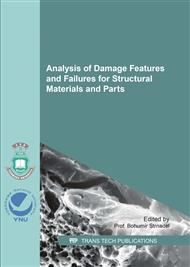p.99
p.105
p.110
p.116
p.122
p.128
p.134
p.138
p.144
Reliability Evaluation of Car Power Module Using Electrical-Thermal-Structural Coupled Analysis Based on Field Driving Data
Abstract:
Power module is a system consisting electronic components to perform the power conversion. Power module is a significant impact on the operation of the equipment and its reliability evaluation is very important. Especially, intermittent electric current flowing in the power module causes repeating the heat generation and cooling. It produces a large thermal stress and cause thermal fatigue failure in the solder part. Car makers usually use the power cycle test to measure the thermal fatigue life. But, it is difficult to simulate the field conditions by this test method. Because, in the actual use environment, the irregular current flows with an irregular cycle. In this research, analysis in the conditions near real usage environment was conducted. It aims at establishment of the reliability assessment method of the power module near a real operating condition.
Info:
Periodical:
Pages:
144-149
Citation:
Online since:
June 2017
Authors:
Keywords:
Price:
Сopyright:
© 2017 Trans Tech Publications Ltd. All Rights Reserved
Share:
Citation:


